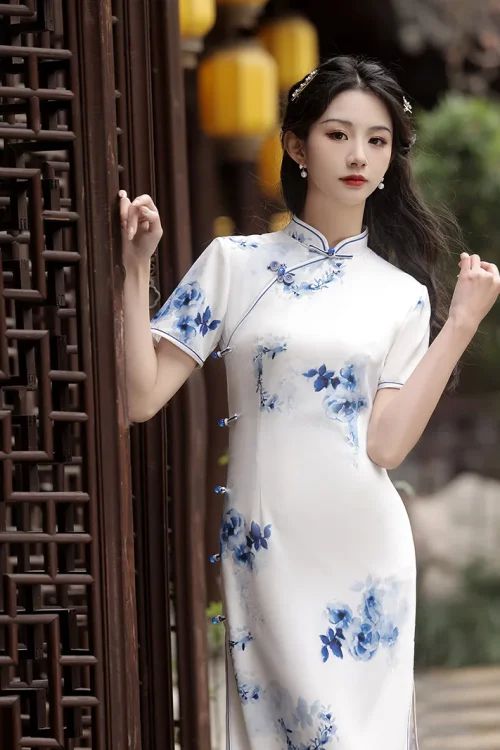The Qipao’s Evolution: A Historical Perspective
The qipao, an iconic Chinese dress, has captivated the world with its timeless elegance and cultural significance. Its evolution through history has been a testament to the changing social and artistic landscape of China.

The Early 20th Century: Symbol of Modernization
In the early 20th century, the qipao emerged as a symbol of modernization and Western influence. Inspired by the Manchu cheongsam, it featured a more fitted silhouette and higher neckline. This new style quickly gained popularity among urban women, who embraced it as a fashionable and practical garment.
The Golden Age: Republican Era
During the Republican era, the qipao reached its golden age. It became a staple of high society, worn by celebrities, socialites, and political figures. Artists like Zhang Daqian and Xu Beihong captured the qipao’s allure in their paintings, depicting women in flowing robes that exuded both grace and sophistication.
Transformation in the 1940s and 1950s
In the 1940s and 1950s, the qipao underwent a transformation. It became more tailored and streamlined, reflecting the changing fashion trends of the post-war era. This new iteration was popularized by actresses such as Audrey Hepburn and Grace Kelly, who wore it on screen and in public appearances.
Cultural Revolution and Resurgence
During the Cultural Revolution, the qipao was suppressed as a symbol of bourgeois decadence. However, it made a resurgence in the 1980s as China began to open up to the world. Contemporary artists like Chen Yifei and Fang Lijun reinterpreted the qipao in their works, exploring themes of identity, nostalgia, and cultural heritage.
The Qipao Today
Today, the qipao continues to be a beloved garment, worn by women of all ages and backgrounds. It symbolizes Chinese culture and inspires artists and designers around the globe. From its humble beginnings to its enduring legacy, the qipao’s journey through time showcases its timeless appeal and the evolving nature of Chinese art and fashion.
The 旗袍 in Contemporary Art: Modern Interpretations
In contemporary art, the qipao has emerged as a captivating subject, inspiring artists to explore its multifaceted symbolism and aesthetic allure. This visual journey traces the qipao’s representation in art, from its origins to modern interpretations.

Early 20th Century: National Identity
During the early 20th century, the qipao gained popularity as a symbol of Chinese identity and modernity. Artists like Xu Beihong and Liu Haisu depicted women in qipaos, capturing their elegance and grace, conveying a sense of national pride and cultural heritage.
Political and Social Change: 1950s and 1960s
In the 1950s and 1960s, the qipao became a symbol of political and social change. Artists like Li Keran and Wu Guanzhong portrayed ordinary women in qipaos, highlighting their strength and resilience, reflecting the changing social landscape of China.
Innovative Modern Interpretations
Contemporary artists continue to reinterpret the qipao in innovative ways. Ai Weiwei’s “Qipao” series features qipaos made from porcelain, challenging traditional notions of beauty and fragility. Zhang Huan’s “Qipao Project” uses qipaos in performance art, exploring themes of identity, memory, and the body.
Gender and Sexuality Themes
Other artists have addressed issues of gender and sexuality through the qipao. Liu Wei’s “Qipao Portraits” blur the lines between traditional and contemporary aesthetics, while Yang Fudong’s film “Seven Intellectuals in Bamboo Forest” explores female desire and agency.
Enduring Cultural Significance
The qipao’s representation in contemporary art reflects its enduring cultural significance. Artists draw inspiration from this iconic garment, using it to explore themes of identity, history, and the human experience, ensuring its relevance in the evolving landscape of art.
The Qipao as a Symbol of Cultural Identity: Artistic Expressions
The qipao has captivated the imaginations of artists for centuries. Its elegant silhouette and intricate designs make it a timeless symbol of cultural identity, inspiring countless artistic expressions.

Early 20th Century: Liberation and Progress
In the early 20th century, the qipao emerged as a symbol of modernization and liberation. Artists such as Xu Beihong and Liu Haisu depicted women in qipaos as symbols of a new, progressive China, capturing their grace and confidence as they broke away from traditional gender roles.
Western Fascination
As the qipao gained popularity, it fascinated Western artists. In the 1930s, American artist Bernard Boutet de Monvel created paintings featuring Chinese women in qipaos, celebrating the dress’s beauty and exoticism while capturing cultural exchanges between East and West.
Nostalgia and Cultural Continuity
In the post-World War II era, the qipao continued to inspire artists. Chinese painters like Li Keran and Wu Guanzhong incorporated the qipao into landscapes to evoke nostalgia and cultural continuity, depicting women amidst traditional architecture.
Contemporary Reflections
Contemporary artists have embraced the qipao as a symbol of cultural identity. In the 1990s, Zhang Huan created photographs featuring women in qipaos made from traditional fabrics, exploring the relationship between the qipao and Chinese history.
Cultural Pride and Empowerment
In recent years, the qipao has become a symbol of cultural pride and empowerment for Chinese women. Artists like Liu Bolin and Yin Xiuzhen use the qipao to address gender, identity, and social change, sparking conversations about women’s roles in society and the importance of preserving cultural heritage.
Timeless Representation
Through art, the qipao has evolved from a symbol of modernization to a timeless representation of cultural identity. Artists capture its beauty, cultural significance, and ability to inspire and empower, ensuring the qipao’s legacy continues to thrive as a source of inspiration.
